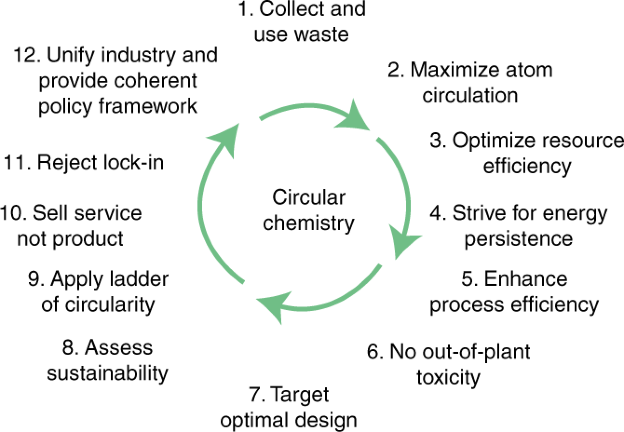Circular Economy and Me – Issue 15

How do we as Consumers of Chemical Products Help Transition the Industry to a Circular Chemical Economy? By Ben Cummings
Introduction
The chemical industries are vital to worldwide health and wealth. They continue to grow and diversify through the innovation of new chemicals that improve our day-to-day lives. Global revenues from the chemical industries have reached $5.7 tr [1], however the ingredients for manufacturing consumer chemical products such as surfactants, adhesives, gums, and waxes still depend on cheap fossil fuels that contribute to environmental degradation and global warming. We need to explore new ways of lowering our reliance on raw materials, energy, and land-use to curb emissions generated throughout the product lifecycle of today’s consumer products.
Circularity of Chemical Products
One solution is to develop a circular chemical economy that prevents waste emissions to the environment while generating economic and social value at multiple stages of the product lifecycle. A circular economy prevents the loss of material (including fluids) from entering the environment as litter, landfill mass, or incineration fumes at end-of-life. Recent efforts to move towards a circular economy currently take the form of chemical products with close to zero lifecycle greenhouse gas emissions. For example, Unilever among others have developed a detergent that contains a surfactant manufactured using captured CO2 emissions from the highly energy intensive steel industry. Such products provide the lifeblood of sustainable growth in the field as they create opportunity for continuous improvement in commercial product performance while decoupling economic growth from environmental impacts.
There are commercial chemical-based products available to buy that demonstrate the circular economy potential of the industry, however these are mainly polyolefin products such as polyethylene and polypropylene packaging that are separated for recycling at materials recovery facilities. Olefins account for over 70% of all organic chemical production and are commonly converted into a range of products including solvents, synthetic rubbers, chemical fibres, and high-value speciality chemicals [2]. Circular business models must consider olefin-based product reuse, remanufacture, and recycling to best implement circular practices, which are broad in their definition and scope as shown by Figure 1. Recycling olefin derived solvents is making great progress because companies minimise disposal costs while cutting down on their virgin solvents inventories. Solvent companies not only save money on storage this way but also minimise harmful toxins released into the earth.

Industry and academia led research efforts to create circular flows of chemicals are addressing the pertinent hurdle of single-use products that, when engineered with compliant recycling methods or compatible molecules hold the potential to be re-introduced into the economy as a range of secondary feedstocks available for conversion back into valuable products. Chemical recycling breaks plastics down into valuable small molecule feedstocks, and this is particularly attractive for upcycling typically hard to recycle waste plastic films and wraps using low energy and high selectivity light driven methods. Light driven catalysis is being used to convert captured carbon dioxide fumes into synthetic feedstock for valuable chemicals and fuels [4]. Examples of novel commercial approaches aiming to help move towards a circular chemical economy through industrial symbiosis include Gum-Tec® who recycle chewing gum into injection mould grade plastics, and Fishy Filaments® who recycle end-of-life monofilament fishing nets into pellets and 3D printer filament. At a more industrial level where resin-based composites are a focus point to transition to Net Zero [5], Boeing is investing in a strategic research collaboration with the University of Nottingham in all its composite recycling activities, and Adesso Advanced Materials and Connora Composites are discovering profitable applications to reintroduce wind turbine blades back into the economy.
A hotspot of the chemical industry is renewable catalysts development. One exciting catalyst is based not on precious metals like gold and platinum, but rather on something you can get out of a banana: potassium [6]. This and similar works utilise quantum devices to design and manufacture chemicals for pharmaceuticals, agriculture and cosmetics in a much more environmentally friendly way than traditional methods. If made at low cost, renewable catalysis can drive financially competitive green chemistry. This way the greener technology backed markets can begin to compete more openly as their green credentials will diversify and will not depend so strongly on carbon offsetting [7]. From a downstream consumer loyalty perspective, companies that sell products of low cost and carbon footprint leverage a populations willingness to protect their environment and avoid damaging it, fostering trust.
Understanding Consumer Behaviour
As researchers innovate new circular solutions to the problem of single-use chemical consumer products, the question becomes ‘how can consumers play their part without the resources available to business or political actors’ to help transition the chemical industry towards more circular practices? To arrive at answers, there must be knowledge gained on public sentiments, cognitive pathways, and primary concerns of the masses [8]. To achieve this, there must be accountability across the product value chain for behaviour change measures to be trustworthy and accepted by the public. Consumer behavioural studies is a complex field of research in its own right because it draws from many social science principles. Word of mouth communication and shared experiences of circular options at a community level is paramount to the success of interventions such as labelling rules and requirements that promote the benefits of a circular chemical economy [9]. As is product pricing and price stability. Aside from greenwashing, other barriers include false claims or ‘fake news’ that can lead to a loss of trust in otherwise promising business efforts that improve upon product sustainability. For example, one of the most common false claims made against lithium-ion battery powered vehicles is that they offer little or no climate benefit over conventional cars, due to the emissions associated with making their batteries [10].
From the authors perspective, there is a consensus among key stakeholders that there currently exist a myriad of interventional methods that can prevent the public from unintentionally buying unsustainable products but few or none that reward for purchasing more circular products. One incentive that WRAP highlighted in a scoping study in March of 2023 is the use of carbon credits to incentivise using recycled materials in consumer products. This can include direct monetary gain for consumers [11, 12].The work being carried out by the Centre for Circular Chemical Economy (Circular Chem) in collaboration with WRAP is focussing on gathering data and qualitative insights into what i) motivates consumers to buy the chemical products they buy, ii) information consumers would benefit from knowing to allow them to make more informed circular economy-oriented purchases, and iii). prevents businesses from profiting more from circular strategies and business models.
Summary
Synthetic chemicals are used to make all sorts of day-to-day consumer products. As consumers, we hold the ability of gaining the knowledge and means of making sustainable purchases to help collectively transition the chemical industry to a circular economy. Hurdles that the industry faces in transitioning are numerous and can be as clear cut as making technological breakthroughs that decouple economic growth from environmental impact, but stem also from more crafty foundations such as greenwashing and false claims. The more sustainable products available for the masses to buy are more often than not too expensive, which should be a primary goal of the industry to reverse. This is best achieved at scale through financial, academic, industrial, and political collaborations. One key synergy for the chemical industry to bolster is with the steel industry by utilising waste emissions such as CO2 rich fume gasses to be used for surfactant manufacture because steel is the most energy intensive industry globally followed by chemicals. Such strategic efforts can be mapped to spotlight heterogeneity of investor perceptions [13]. Considerable industrial advances are required to support an affordable and environmentally responsible circular chemical economy, however, the role of the consumer is primarily to engage actively in educational and experience-based measures that builds trust in transparent brands and those products that move the chemical industry towards Net Zero the fastest.
References
[1] Industries and Markets – Manufacturing: Market Data & Analysis. Statista report (2023).
[2] Royle, M. & Gibson, E. A. Championing Systems Thinking to Create a Circular Economy of Chemicals. Chem 9, 543–546 (2023).
[3] Keijer, T., Bakker, V. & Slootweg, J. C. Circular Chemistry to Enable a Circular Economy. Nat Chem 11, 190–195 (2019).
[4] Gibson, E., Co, A. & Meyer, G. Light-Driven and Electrochemical CO2 Reduction. ACS Applied Energy Materials vol. 7. Preprint, doi.org/10.1021/acsaem.4c00013. (2024).
[5] Hamerton, I., Hobson, L. J. & Wagner, J. Introduction to sustainable composites. RSC Sustainability vol. 2. Preprint, doi.org/10.1039/d3su90060f. (2024).
[6] Silberg, B. Caltech Student Fathers Breakthrough in Green Chemistry. Accessed on 14/06/2024 from: www.climate.nasa.gov/news/2273/caltech-student-fathers-breakthrough-in-green-chemistry.
[7] Gabbatiss, J. Analysis: How Some of the World’s Largest Companies Rely on Carbon Offsets to ‘Reach Net-Zero’. Accessed on 14/06/2024 from https://interactive.carbonbrief.org/carbon-offsets-2023/companies.html
[8] Song, J. et al. Navigating Public Sentiment in the Circular Economy through Topic Modelling and Hyperparameter Optimisation. (2024).
[9] Evans, S. Factcheck: 21 Misleading Myths About Electric Vehicles. Accessed on 14/06/2024 from https://www.carbonbrief.org/factcheck-21-misleading-myths-about-electric-vehicles/
[10] Funke, F & Mattauch, L. Why is carbon pricing in some countries more successful than in others? Accessed on 14/06/2024 from https://ourworldindata.org/carbon-pricing-popular
[11] WRAP. The Use of Recycled Materials in Consumer Products and Potential Chemical Safety Concerns Scoping Study. A report accessed on 14/06/2024 from assets.publishing.service.gov.uk/media/641088288fa8f5560f2ebdef/recycled-materials-in-consumer-products-main-report.pdf. (2023).
[12] Laksmawati, W. K., Hsieh, C. M. & Yang, S. H. Social Influence and Climate Change Issues Affecting Consumer Behavioral Intention Toward Carbon Footprint Label: A study of Taiwanese Consumers. J Clean Prod 444, (2024).
[13] Persad, K., Xu, B. & Greening, P. Institutional Investor Behaviour and the Energy Transition: A complexity Framework for Accelerating Sustainable Finance from UK Investors. Energy Econ 107444. doi:10.1016/j.eneco.2024.107444. (2024).